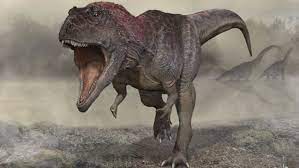Ottawa, Aug 27: The fossil record represents an amazing window into the endless forms of life that have existed across countless ages. By studying ancient species and ecosystems we can increase our understanding of what lived in the past and how the Earth was different compared to today. We can also use fossils to understand how evolution works and what is most likely to evolve under particular sets of circumstances.
This context is what makes Meraxes gigas, a newly named theropod dinosaur, so important for our understanding of dinosaur evolution and biodiversity.
I was part of the international team of palaeontologists, led by Juan Canale of the Ernesto Bachmann Palaeontological Museum, that named and described Meraxes gigas. The specimen was collected between 2012 and 2014 near Villa El Chocón in Argentina, in rocks of the ~95 million year old Huincul Formation.
Top predator
Meraxes is a large theropod, the group of bipedal, often meat-eating, dinosaurs which also includes birds, and a member of the Carcharodontosauridae family, making it a relative of dinosaurs like Carcharodontosaurus, Giganotosaurus and Acrocanthosaurus.
The discovered specimen is approximately 11 metres long, and its weight is estimated as approximately 4,200 kg. It has a proportionally large skull featuring a rather fearsome set of teeth, along with long legs and large clawed feet, a powerful tail, and small arms and hands.
Likely a top predator, it co-occurred with other large theropods like Skorpiovenator, alongside large herbivorous sauropod dinosaurs and smaller iguanadontian ornithopod dinosaurs.
Distant relatives
Meraxes is particularly notable in what it tells us about the evolution of large size in dinosaurs. Its body plan — a large head and small arms — is very similar to that seen in tyrannosaurids like Tyrannosaurus rex, and abelisaurids like Carnotaurus.
These three groups of theropod dinosaurs are all distant relatives. Each independently evolved both large body size and the combination of a large head and small arms.
We analysed the evolution of these changes in these three groups by examining changes in arm size relative to other body measurements, such as leg and body size. We found that not only did each group experience similar changes through evolution, but there appears to be a lower limit for how small the arms can be relative to the rest of the body. This may represent a developmental or mechanical constraint: the arm can only get so small relative to the body, regardless of other evolutionary pressures in this context.
There are several potential explanations for the size of the arms; the forelimbs themselves may have retained some function despite their reduced size. Our data most directly support the idea that arm reduction in these dinosaur groups is more likely tracking other traits rather than being the subject of evolutionary selective pressure itself. In other words, as the relative size of the skull increased over evolution, the arms decreased proportionally in size as an evolutionary trade-off.
Growth charts
Another important thing Meraxes can tell us about dinosaur evolution concerns its growth and age. As a palaeontologist, one of my areas of expertise is in using bone microstructure to understand growth in extinct animals like dinosaurs. I also study how bone growth varies across individuals within and between species.
This involves cutting a bone in half (typically one of the long bones of the hind limb, like a femur or tibia), mounting a piece to a slide, and grinding that piece down to be thin enough that you can pass light through it and view the bone microstructure using a microscope.
From here, changes in bone tissue can be observed, telling us about physiology and relative maturity. We can also see annual growth marks, similar to tree rings. By counting these growth marks, measuring their positions across the bone and analysing them using statistical growth models, we can estimate not only how much an animal grew from year to year, but also how old it was when it died.
Using this approach to study Meraxes, we were able to determine that it was likely around 50 years old at death, and its skeleton had stopped growing about four years before it died. This would make it the oldest non-avian theropod dinosaur currently known, and one of the oldest known dinosaurs.
We also discovered that Meraxes, compared to other gigantic theropods like Tyrannosaurus, reached a large size through very different changes to their growth. Meraxes continued growing for a longer period of time when compared to its smaller relatives. Tyrannosaurus had a greater relative growth rate than smaller tyrannosaurid species, but reached adult size in a similar amount of time.
Independent evolution
As a result, Meraxes and Tyrannosaurus provide a complex example of evolutionary convergence: they both reached very large size when compared to their relatives, and independently evolved the combination of large skulls and small arms. But they achieved this through very different modifications to their growth pattern through life.
As we continue to study Meraxes and other dinosaurs, we’ll further increase our understanding of the amazing biodiversity and changes throughout the Earth’s history. And in doing so, we’ll also gain a greater understanding of the mechanisms of evolution itself. (The Conversation)
(AGENCIES)


